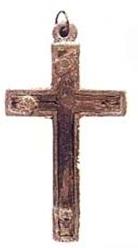A cross inlaid with wood suggested to be possibly wood of the True Cross.
The cross was discovered in late January, 1997 during the excavation of a sixth-century A.D. house or shop just outside Jerusalem’s Jaffa Gate. Crosses have often been discovered before—Jerusalem has long had a flourishing souvenir industry featuring holy oil, holy water and crosses—but this cross is unique because it is inlaid with two pieces of wood. The cross itself appears to be bronze.
“It was probably a souvenir from Jerusalem for pilgrims who came to the city,” says Ronny Reich, the Israel Antiquities Authority archaeologist co-directing the excavation with Ya’akov Billig.
Archaeologists think the cross dates from the Byzantine period, between the fifth and eighth centuries A.D., when Jerusalem was under Christian rule. Reich, along with other Israeli archaeologists, doubts the inlaid wood came from Jesus’ cross. But to identify the type of wood and pinpoint its age, it must undergo scientific testing. Dating the relic by the radiocarbon method will destroy the wood. Says Reich, “Would you like for us to keep the wood in the cross? But then we will not know from which period of time it is! Or, if we sacrifice it and make our carbon-14 analysis, then we’ll have no wood anymore.”
Rocheman, Bonne, “A True Crux.” BAR, May-Jun 1997.
